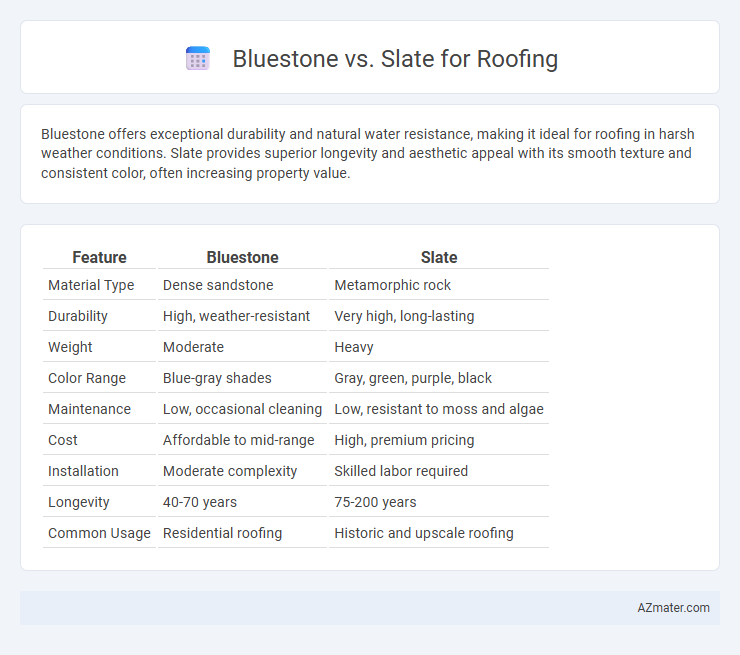Bluestone offers exceptional durability and natural water resistance, making it ideal for roofing in harsh weather conditions. Slate provides superior longevity and aesthetic appeal with its smooth texture and consistent color, often increasing property value.
Table of Comparison
| Feature | Bluestone | Slate |
|---|---|---|
| Material Type | Dense sandstone | Metamorphic rock |
| Durability | High, weather-resistant | Very high, long-lasting |
| Weight | Moderate | Heavy |
| Color Range | Blue-gray shades | Gray, green, purple, black |
| Maintenance | Low, occasional cleaning | Low, resistant to moss and algae |
| Cost | Affordable to mid-range | High, premium pricing |
| Installation | Moderate complexity | Skilled labor required |
| Longevity | 40-70 years | 75-200 years |
| Common Usage | Residential roofing | Historic and upscale roofing |
Introduction to Bluestone and Slate Roofing
Bluestone roofing offers durability and a unique blue-gray hue derived from natural sedimentary rock, prized for its resistance to weathering and aesthetic appeal in traditional and contemporary architecture. Slate roofing, made from fine-grained metamorphic rock, is highly valued for its long lifespan, natural cleavage, and variety of colors ranging from gray to green, red, and black, providing exceptional fire resistance and low maintenance. Both materials contribute significantly to enhancing roof longevity and energy efficiency, with slate generally priced higher due to its natural refinement and installation complexity.
Material Composition: Bluestone vs Slate
Bluestone is a dense, fine-grained sandstone composed primarily of quartz and feldspar, offering durability and resistance to weathering for roofing applications. Slate is a metamorphic rock made mostly of clay minerals and mica, known for its natural cleavage that allows it to be split into thin, waterproof tiles ideal for roofing. The mineral composition of slate provides superior longevity and fire resistance compared to bluestone, making it a preferred choice for high-end roofing projects.
Aesthetic Appeal and Color Variations
Bluestone offers a consistent, modern aesthetic with shades ranging from deep blue to gray, providing a sleek and uniform appearance ideal for contemporary roofing designs. Slate boasts a broader color palette, including greens, purples, reds, and blacks, allowing for more traditional or rustic styles with natural variation and rich texture. The choice between bluestone and slate for roofing depends on desired visual impact, with bluestone emphasizing uniformity and slate offering diverse, vibrant color options.
Durability and Weather Resistance
Bluestone offers exceptional durability with its dense, fine-grained structure, making it highly resistant to cracking and chipping under heavy impact or extreme weather conditions. Slate, renowned for its natural cleft surface and layered mineral composition, provides superior weather resistance, withstanding frost, rain, and UV exposure for over a century without significant deterioration. Both materials excel in longevity, but slate's proven performance in harsh climates often gives it an edge in roofing applications demanding maximum weather resilience.
Installation Process and Ease
Bluestone roofing requires precise cutting and shaping due to its dense, smooth texture, making the installation process more labor-intensive and suitable for experienced roofers. Slate roofing, characterized by its natural cleavage planes, offers easier splitting and consistent thickness, simplifying the installation and allowing for faster placement. Both materials demand careful handling to avoid breakage, but slate's uniformity generally results in a quicker and less complex installation compared to bluestone.
Cost Comparison: Initial and Long-term
Bluestone roofing typically costs between $7 and $10 per square foot, with an initial investment that is moderate compared to other natural stones, while slate roofing ranges from $10 to $20 per square foot due to its higher durability and aesthetic appeal. Long-term costs for bluestone are generally lower in maintenance but may require more frequent replacements, whereas slate offers exceptional longevity, often exceeding 75 years, resulting in reduced long-term expenses despite the higher upfront price. Homeowners should weigh the initial cost premium of slate against its superior lifespan and lower maintenance, making slate more cost-effective over decades.
Maintenance Requirements
Bluestone roofing requires minimal maintenance due to its high durability and resistance to weathering, making it ideal for various climates with infrequent inspections and occasional cleaning. Slate roofing demands more rigorous upkeep, including regular inspections for cracked or loose tiles and prompt repairs to maintain its longevity and prevent leaks. Both materials benefit from professional maintenance to preserve their structural integrity and aesthetic appeal over time.
Longevity and Lifespan
Bluestone roofing offers impressive durability, often lasting between 75 to 100 years due to its dense composition and resistance to weathering. Slate roofs are renowned for their exceptional longevity, with lifespans commonly exceeding 100 years and in some cases surpassing 150 years if properly maintained. Both materials provide excellent resistance to environmental factors, but slate generally outperforms bluestone in terms of overall lifespan and long-term value.
Environmental Impact and Sustainability
Bluestone and slate roofing materials differ significantly in environmental impact and sustainability, with bluestone often sourced from quarries that practice eco-friendly extraction methods reducing habitat disruption. Slate boasts exceptional durability and longevity, often lasting over a century, which minimizes waste and resource consumption over time. Choosing locally sourced bluestone or slate can lower transportation emissions, making both options viable sustainable roofing materials depending on regional availability.
Choosing the Right Stone for Your Roof
Bluestone and slate are both durable roofing materials valued for their natural beauty and longevity, but selecting the right stone depends on factors like climate, aesthetic preferences, and budget. Bluestone offers a unique blue-gray hue with moderate weight and excellent frost resistance, making it suitable for colder regions, while slate is known for its classic dark appearance, superior hardness, and longer lifespan but comes at a higher cost. Considering installation complexity and maintenance requirements is crucial, as slate often requires skilled labor due to its brittleness, whereas bluestone is easier to work with yet still provides reliable protection against the elements.

Infographic: Bluestone vs Slate for Roofing
 azmater.com
azmater.com